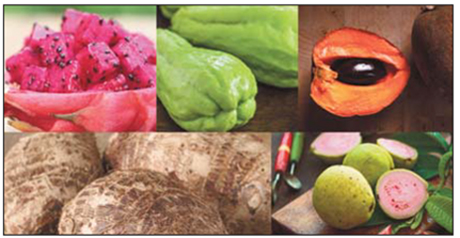Welcome to Blue Book!
Are you ready to join the thousands of companies who rely on Blue Book to drive smarter decisions? View our plans and get started today!
Still have questions? We’d love to show you what Blue Book can do for you. Drop us a line– we’ve been waiting for you.

A New World native, malanga grows in Central America, South America, and the Caribbean as well as in the Philippines and West Africa, where it has become a food staple. Most of the product consumed in the United States comes from Costa Rica, Ecuador, and Florida and is available year-round. A relative of taro root, malanga boasts a nutty flavor. It’s often treated like a potato and boiled, mashed, or fried, but is also used as a thickener for soups and stews.
“We sell a lot of malanga to grocery suppliers,” observes Capote, whose family is Cuban. “In today’s world, you can find the mainstream roots, the top commodities I grew up eating, at most retailers.”
Malanga should be stored at room temperature and, once purchased, eaten within a week. The most surprising thing about this root is its benefit to health—not only is malanga rich in potassium and fiber, it’s also considered one of the most hypoallergenic foods in the world. People with severe allergies often use malanga flour as a substitute for wheat or white flour.
PERPLEXING PITAYA
If there’s one Hispanic commodity rocketing up the list, it is pitaya, often called pitahaya or dragon fruit. Both are from cactus plants: pitahaya is the fruit of the genus Hylocereus and is sweet in flavor, while pitaya is fruit of the Stenocereus genus and is sour. Originally grown in Mexico, pitaya is now cultivated in Central America and South Florida, as well as in Southeast Asia, Israel, and Hawaii.
Part of pitaya’s mystique is an astonishing hot-pink husk, which may account for its newfound popularity. Or maybe its designation as a superfood has made consumers, retail chains, foodservice giants, and highbrow chefs take notice. One thing is certain: pitaya is high in numerous vitamins, iron, phosphorus, magnesium, and calcium, and also boasts antioxidant properties. What’s more, the crunchy little black seeds found in the flesh are full of crucial Omega-3 fatty acids.
“Ten years ago, dragon fruit didn’t retail out of Florida for less than $9.00 per fruit,” comments J&C Tropicals’ Capote. “Since then, there’s been a boom in the number of growers planting dragon fruit. I see big growth when consumers are educated about new items and then introduced to them. Dragon fruit is one of those items, and it’s very, very popular.”
The proof is in the numbers: J&C Tropicals sold about 10,000 pounds of pitaya in June 2014; in June of this year, the company had sold more than 100,000 pounds.
Not only is pitaya a superfood, it’s also tasty. Typically eaten raw, pitaya flesh varies in color from white to dark red and has the texture of kiwifruit. The sour variety tends to be juicier with a more distinctive flavor, while the sweet is milder. In Mexico, one of the most popular uses for pitaya is to make a refreshing agua fresca (a fruit drink) consisting of fruit, ice, water, and if needed, sugar. Agua frescas are sold in supermarkets, open-air markets, and at stands across Mexico.




